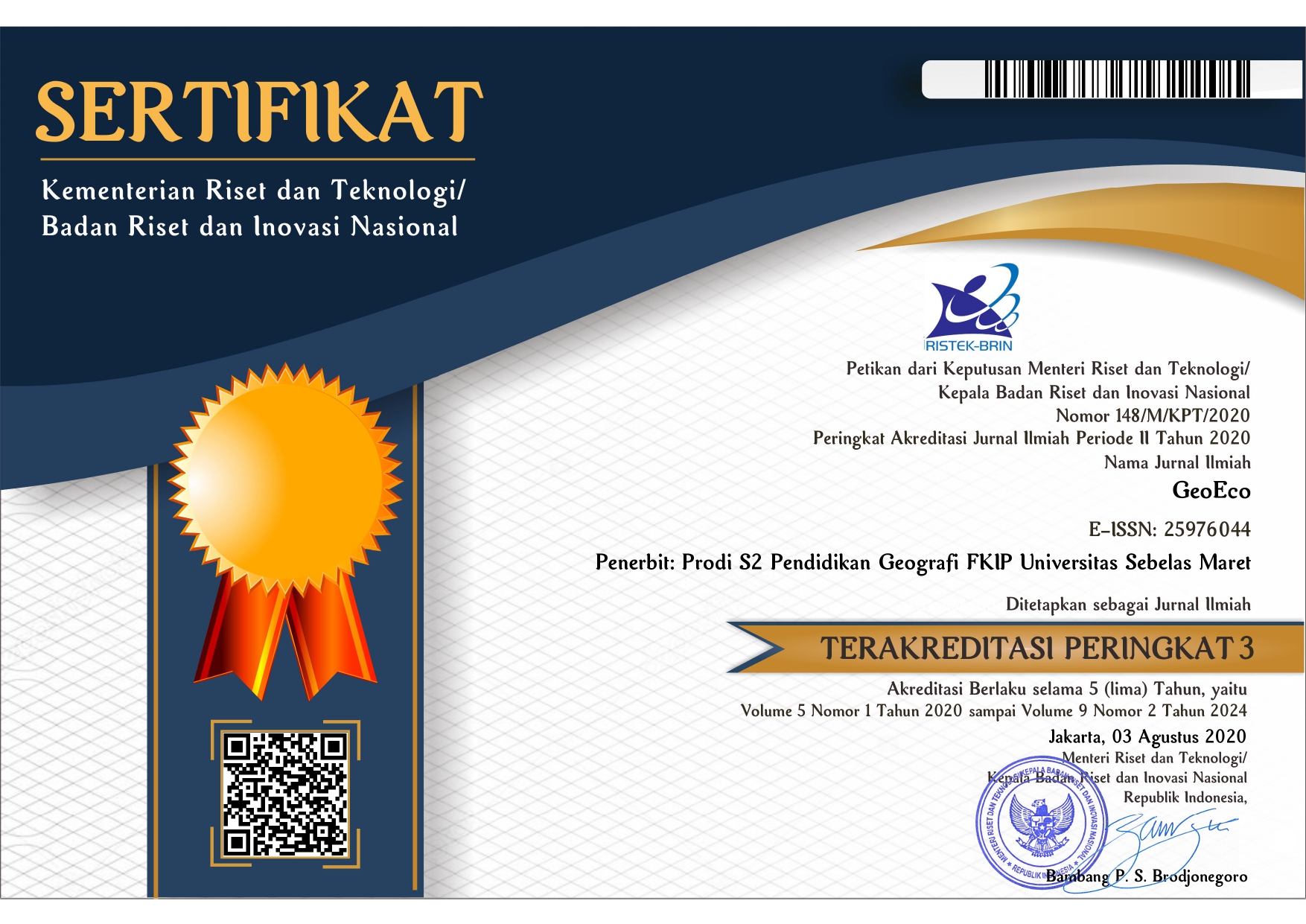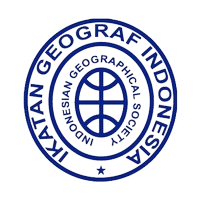SPATIAL DISTRIBUTION OF ECO-FRIENDLY COFFEE SHOPS IN MALANG CITY
Abstract
Along with the increasing population and lifestyle of people drinking coffee, coffee shops increased significantly. This not only impacts socially and economically but also impacts the environment. Sustainability demands coffee shops to manage environmental problems that arise from business activities. This article aims to examine the environmental aspects (energy, water, waste) and spatial aspects of coffee shops in Malang city. The methodology of this research was focused on data acquisition related to tabular and geospatial information provided online through social media, news websites, and online food order applications. Descriptive quantitative and spatial approaches were made in this research. The results showed that most coffee shops in Malang city-operated daily for 7-12 hours, provided food and beverages, and used a combination of glass/porcelain and disposable materials as the packaging. These could trigger problems related to high energy and water consumption and waste generalization. Meanwhile, several coffee shops began to initiate the green action by using steel straw, reusing cups, and reducing plastic. As located mainly in the city center and densely populated area, the local government should pay more attention to this area regarding environmental management and urban planning. Hopefully, the emergence of coffee shops can contribute positively socially and economically without exacerbating the urban environmental problems.
Keywords
Full Text:
PDFReferences
Albab, M. U. (2019). Pedagang Mobile Cafe, Terima Sampah untuk Secangkir Kopi. https://www.merdeka.com/peristiwa/pedagang-mobile-cafe-terima-sampah-untuk-secangkir-kopi.html
Azzuhri, M., & Tanjung, A. D. (2018). Interior Design at Coffee Shop as a Factor Influencing Customer Retention and Mediating Role of Perceived Customer Satisfaction. Journal of Entrepreneur and Entrepreneurship, 6(2), 43–54.
Biswas, A. (2016). Impact of Social Media Usage Factors on Green Choice Behavior Based on Technology Acceptance Model. Journal of Advanced Management Science, 4(2), 92–97. https://doi.org/10.12720/joams.4.2.92-97
BPS Kota Malang. (2021). Kota Malang dalam Angka 2021. https://malangkota.bps.go.id
Cakranegara, P. A. (2020). Gerai Kopi di Jakarta dalam Adaptasi Kehidupan Baru. EDUTOURISM Journal Of Tourism Research, 2(02), 1–7. https://doi.org/10.53050/ejtr.v2i02.133
Eswaran, B., Bhuvaneswari, V., Sivasankari, P., & Mangalalakshmi, B. (2020). Online food orders: Customers’ preference with reference to north Chennai. Journal of Critical Reviews, 7(6), 23–26. https://doi.org/10.31838/jcr.07.06.06
Ferreira, J., & Ferreira, C. (2018). Challenges and opportunities of new retail horizons in emerging markets: The case of a rising coffee culture in China. Business Horizons, 61(5), 783–796. https://doi.org/10.1016/j.bushor.2018.06.001
Filimonau, V., Krivcova, M., & Pettit, F. (2019). An exploratory study of managerial approaches to food waste mitigation in coffee shops. International Journal of Hospitality Management, 76, 48–57. https://doi.org/10.1016/j.ijhm.2018.04.010
Fitrianingrum, A., & Angga, M. (2019). Analisis Faktor yang Mempengaruhi Minat Pembelian Milenial terhadap Local Coffee Shop. Dimensi, 8(3), 485–497.
Giraldi-Díaz, M. R., De Medina-Salas, L., Castillo-González, E., & León-Lira, R. (2018). Environmental impact associated with the supply chain and production of grounding and roasting coffee through life cycle analysis. Sustainability (Switzerland), 10(12). https://doi.org/10.3390/su10124598
Green Restaurant Association. (2021). Green Restaurant Certification Standards. https://www.dinegreen.com/certification-standards
Gumilang, M., Yuliati, L., & Indrawan, R. (2021). Repurchase Intention of Millennial Generation in Coffee Shop with the Coffee-To-Go Concepts. Academia.Edu, 8(2), 347. https://www.academia.edu/download/65885571/IJRR048.pdf
Gumulya, D., & Helmi, I. S. (2017). Kajian Budaya Minum Kopi Indonesia. Jurnal Dimensi Seni Rupa Dan Desain, 13(2), 153. https://doi.org/10.25105/dim.v13i2.1785
Hamidah, N., Rijanta, R., Setiawan, B., & Aris Marfai, M. (2014). Model Permukiman Kawasan Tepian Sungai Kasus : Permukiman Tepian Sungai Kahayan Kota Palangkaraya. Jurnal Permukiman, 9(1), 17–27.
Hardiyanti, N. Y., & Puspa, R. (2021). Coffee Culture di Indonesia : Pola Konsumsi Konsumen Pengunjung Kafe, Kedai Kopi dan Warung Kopi di Gresik. Jurnal Media Dan Komunikasi, 2(1), 26. https://doi.org/10.20473/medkom.v2i1.26380
Harrison, D., & Kain, J. F. (1974). Cumulative urban growth and urban density functions. Journal of Urban Economics, 1(1), 61–98. https://doi.org/10.1016/0094-1190(74)90024-2
Ifani, S. M. (2019). Local Wisdom in Coffee House Design to Promote Gayo Culture and Tourism. International Journal of Architecture and Urbanism, 3(1), 32–42. https://doi.org/10.32734/ijau.v3i1.790
Intentilia, A. A. M. (2020). Coffee Diplomacy in Jokowi’s Era : The Strategy of Cultural and Economic Diplomacy of Indonesia’s Foreign Policy. Jurnal Ilmiah Dinamika Sosial, 4(1), 63–81.
International Coffee Organization. (2021). World coffee consumption. https://www.ico.org/prices/new-consumption-table.pdf
Jeon, M.-S., & Jo, M.-N. (2011). A Study on Coffee Shop Use and the Influence of Physical Environment of Coffee Shop on Customer Behavioral Intention - focused on college students in Seoul, Gyeonggi province. Korean Journal of Food and Cookery Science, 27(6), 825–838. https://doi.org/10.9724/kfcs.2011.27.6.825
Kanyan, A., Ngana, L., & Voon, B. H. (2016). Improving the Service Operations of Fast-food Restaurants. Procedia - Social and Behavioral Sciences, 224(August 2015), 190–198. https://doi.org/10.1016/j.sbspro.2016.05.439
Li, M., He, B., Guo, R., Li, Y., Chen, Y., & Fan, Y. (2018). Study on Population Distribution Pattern at the County Level of China. Sustainability 2018, Vol. 10, Page 3598, 10(10), 3598. https://doi.org/10.3390/SU10103598
Linard, C., Gilbert, M., Snow, R. W., Noor, A. M., & Tatem, A. J. (2012). Population Distribution, Settlement Patterns and Accessibility across Africa in 2010. PLOS ONE, 7(2), e31743. https://doi.org/10.1371/JOURNAL.PONE.0031743
Maulana, R. R., Cahyono, U. J., & Muqoffa, M. (2021). Spatial distribution in the emergence of coffee shops in Surakarta. IOP Conference Series: Earth and Environmental Science, 778(1). https://doi.org/10.1088/1755-1315/778/1/012031
Mostafa, M. M. (2008). 2008 - Mostafa - Antecedents of Egyptian Consumers’ Green Purchase Intentions : A hierarchical multivariate regression model (pp. 97–126). https://doi.org/10.1300/J046v19n02_06
Nonaka, T., Shimmura, T., Fujii, N., & Mizuyama, H. (2015). Energy Consumption in the Food Service Industry: A Conceptual Model of Energy Management Considering Service Properties. IFIP Advances in Information and Communication Technology, 460, 605–611. https://doi.org/10.1007/978-3-319-22759-7_69
Nurani, I. W., Muta, L., Tyas, E., Mei, W., Budi, S., Fajarwati, A., Ridwan, B. Y., Maharani, N., & Pradipta, A. (2019). Reducing Greenhouse Gasses Emission from Energy Consumption in Floating Net Cage Aquaculture ( FNCA ). Proceeding International Summit on Science Technology and Humanity (ISETH, 749–754.
Nurani, I. W., Wibowo, S. B., Maharani, N., & Ridwan, B. Y. (2020). Emisi Gas Rumah Kaca (GRK) dari Permukiman di Kabupaten Bandung. In S. Ritohardoyo, R. Rijanta, & M. Baiquni (Eds.), Perkembangan Permukiman dan Pembangunan Wilayah di Indonesia (1st ed., pp. 143–155). Badan Penerbit Fakultas Geografi, Universitas Gadjah Mada.
Nurani, I. W., Wibowo, S. B., Prihastopo, Z. I., Pelangi, A. P., & Sunardi, S. (2020). Contribution of waste bank in reducing greenhouse gas emissions in Bandung Regency. E3S Web of Conferences, 200, 1–5. https://doi.org/10.1051/e3sconf/202020002004
Nurani, I. W., Wibowo, S. B., Rahmawati, Y., & Anggraeni, R. D. (2020). Lingkungan dan Covid-19: Build Back Better from Home. In R. Rijanta & M. Baiquni (Eds.), Rembug Pageblug: Dampak, Respons dan Konsekuensi Pandemi Covid-19 dalam Dinamika Wilayah (1st ed., pp. 59–86). Badan Penerbit Fakultas Geografi, Universitas Gadjah Mada.
Nurhasanah, S., & Dewi, C. (2019). The Emergence of Local Coffee Shops in Indonesia. Rubikon: Journal of Transnational American Studies, 6(1).
Peraturan Daerah No.4 Rencana Tata Ruang Wilayah Kota Malang tahun 2010-2030 (2011).
Pena Moreno, C. A., & Salgado, O. (2014). Sustainability indicators along the coffee value chain: A comparative study between Mexican & Colombian retail. 1–10.
Purnomo, M., Yuliati, Y., Shinta, A., & Riana, F. D. (2021). Developing coffee culture among indonesia’s middle-class: A case study in a coffee-producing country. Cogent Social Sciences, 7(1). https://doi.org/10.1080/23311886.2021.1949808
Putranto, F. E., & Hudrasyah, H. (2017). Identification of Consumer Decision Journey in Choosing Third Wave Coffee Shop in Bandung By Youth Market Segment. Journal of Business and Management, 6(1), 88–100.
Richardson, H. W. (1976). Dasar-dasar Ilmu Ekonomi Regional. FE UI.
Saito, O. (2013). Resource Use and Waste Generation by the Tourism Industry on the Big Island of Hawaii. Journal of Industrial Ecology, 17(4), 578–589. https://doi.org/10.1111/JIEC.12007
Samnuzulsari, T., Edison, E., & Yudiatmaja, W. E. (2019). From Popular to Partisan Public Sphere: The Political Change of the Coffee Shops in Kepulauan Riau. Komunitas: International Journal of Indonesian Society and Culture, 11(1), 119–128. https://doi.org/10.15294/komunitas.v11i1.17235
Si, J., Lin, -Shyun, Lai, H. H.-S., & Chen, H.-Y. (2015). The Study of the Relationship between Store Green Practices and Consumer’s Perception of Sustainability Brand Image toward Coffee Store. American Journal of Tourism Management, 4(2), 35–39. https://doi.org/10.5923/j.tourism.20150402.02
Singh, S. K., Kaushik, V., Soni, S., & Lamba, N. (2014). Waste Management in Restaurants : A Review. International Journal of Emerging Engineering Research and Technology, 2(2), 14–24.
Sirikan, K. (2018). Water Benchmarking Study : Restaurants and Microbreweries. August.
Styles, D., Schönberger, H., & Martos, J. L. G. (2013). Best Environmental Management Practice in the Retail Trade Sector Learning from frontrunners. https://doi.org/10.2788/33972
Suarez, A. N., Koelenlacay, J., Villanueva, V., Ashley Velasquez, R., Reyes, C., Serrano, V., & Borbon, C. D. (2017). Impacts of Coffee Shop Business to Tourism Industry in Three Cities of Batangas, Philippines. Journal of Tourism and Hospitality Research, 14(1).
Sustaination. (2019). #SustainHero 5: #2019NggantiPlastik, perjalanan menuju minim sampah ala Kon Kopi a? https://sustaination.id/sustainhero-5-2019nggantiplastik-perjalanan-menuju-minim-sampah-ala-kon-kopi-a/
Syarifudin, A. (2018). Di Kedai Kopi Ini, Secangkir Kopi Bisa Dibayar Pakai Sampah Botol Plastik. https://jogja.tribunnews.com/2018/07/09/di-kedai-kopi-ini-secangkir-kopi-bisa-dibayar-pakai-sampah-botol-plastik
Tallo, A., Pratiwi, Y., & Astutik, I. (2014). Identifikasi Pola Morfologi Kota (Studi Kasus : Kecamatan Klojen, Kota Malang). Jurnal Perencanaan Wilayah Dan Kota, 25(3), 213–227. https://doi.org/10.5614/jpwk.2015.25.3.3
Taqwadin, D. A., Sulaiman, A. N., Akmal, S., & Fauzan, I. (2019). Potensi Budaya Minum Kopi (Ngopi) dalam Membangun Kembali Koeksistensi Masyarakat Aceh Paska Konflik. Jurnal Ilmiah Islam Futura, 86–102(1), 86–102.
The Sustainability Consortium (TSC). (2017). Coffee Production and Sustainability - The Sustainability Consortium’s Commodity Mapping Report. September, 1–20. https://www.sustainabilityconsortium.org/tsc-downloads/coffee-production-sustainability-sustainability-consortiums-commodity-mapping-report/
Vardoulakis, S., & Kinney, P. (2019). Grand Challenges in Sustainable Cities and Health. Frontiers in Sustainable Cities, 0, 7. https://doi.org/10.3389/FRSC.2019.00007
Viartasiwi, N., & Trihartono, A. (2020). Café in small towns: A picture of the weakening social engagement. Coffee Science, 15(1), 1–6. https://doi.org/10.25186/.V15I.1687
Wibowo, S. B., & Nurani, I. W. (2019). Improving geoinformation technology by incorporating local participation. November 2019, 43. https://doi.org/10.1117/12.2550320
Yun, S., & Kim, T. (2019). What do coffee shop entrepreneurs need to do to raise pro-environmental customer behavioral intentions? Sustainability (Switzerland), 11(9). https://doi.org/10.3390/su11092666
Zahra, S. T., Setia, E., & Zein, T. (2021). Linguistic landscape on coffee shop signboards in Medan. Budapest International Research and Critics Institute-Journal (BIRCI-Journal), 4(3), 5445–5457.
Zhang, H. H., Zeng, Y. N., & Bian, L. (2010). Simulating multi-objective spatial optimization allocation of land use based on the integration of multi-agent system and genetic algorithm. International Journal of Environmental Research, 4(4), 765.
Refbacks
- There are currently no refbacks.












.png)

